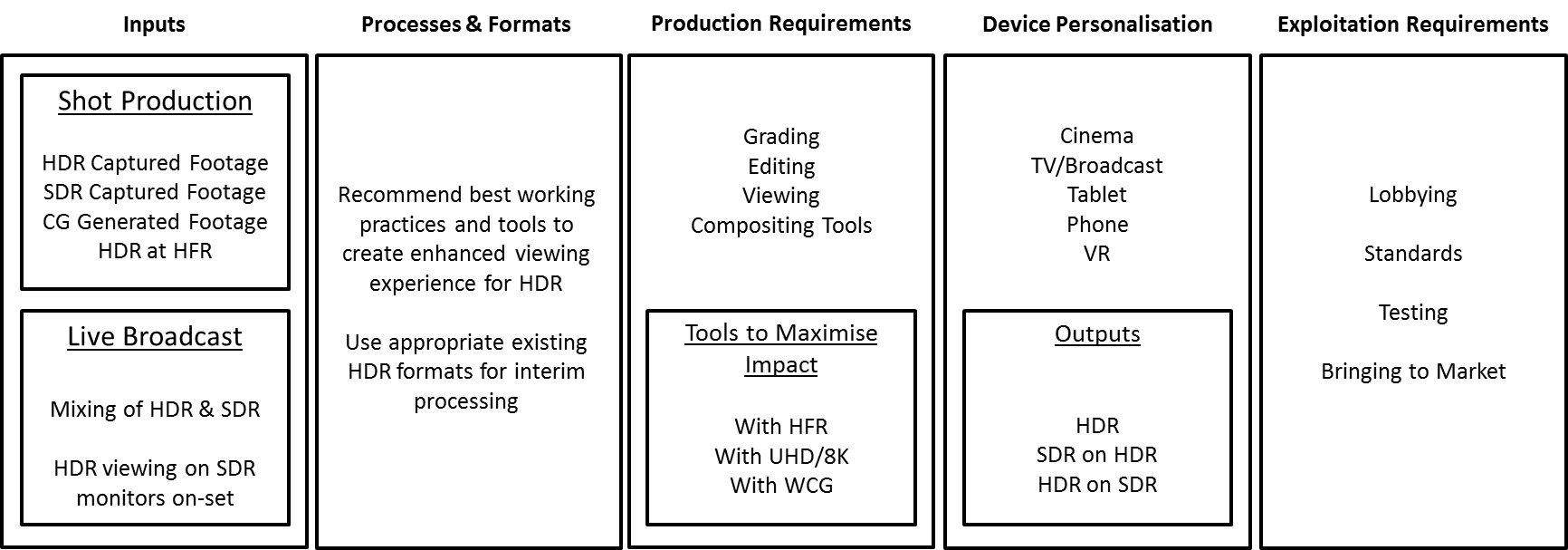Objectives
The main goal of HDR4EU is to position EU companies in the creative sector as world leaders in the emerging HDR format by producing, piloting and demonstrating a set of professional tools, techniques and guidelines allowing for an HDR ecosystem to emerge, yielding a notably superior viewer experience in terms of image quality and content personalization. HDR4EU addresses all open challenges by having the following specific and measurable objectives that directly map onto work packages and tasks as described in the Implementation section:
- Producing guidelines on how to shoot and post-produce HDR footage in a way that maximizes the expressive capabilities of the HDR medium while considering the limitations of visual perception with respect to HDR images, based on exemplary content created and demonstrated in the project;
- Piloting and demonstrating high quality real-time tools for conversion among HDR and SDR formats and among standard and wide colour gamuts, which are essential for HDR capture, monitoring, post-production, distribution and display, for cinema, TV, videogames and AR/VR;
- Producing and demonstrating colour management and grading tools so that the mastering process has a simple workflow that can deliver consistent images across the whole spectrum of possible display devices and environments;
- Creating a first market implementation of live (immersive) HDR content generation tools for broadcasting, and a web implementation for broadband internet;
- Demonstrating and validating a new product: an HDR projection system for movie theatres, since traditional cinema projector technology is not capable of providing images with a dynamic range that is actually high;
- Producing and demonstrating automated and user-assisted personalization tools, allowing content to be adapted to the viewer’s personal characteristics and individual preferences, as well as to the viewing environment.

A key aspect of HDR4EU is to ensure industry adoption. The outcomes of HDR4EU will be validated, demonstrated and disseminated. Techniques usually have well accepted evaluation methods: efficiency, robustness, real-time suitability, comparison with state-of-the-art and viewing tests with end-users. Tools, guidelines, and pipelines require validation by professional users, in life-like situations, with varied type of content. One of the consortium members will act as a model professional user and will validate with a range of professionals, and provide feedback on, the tools, techniques and guidelines produced, using their knowledge of the needs of industry clients, to guarantee that they are fit for purpose. We will also conduct extensive and thorough user tests with established metrics to verify that the viewing experience is substantially improved. The industry partners all have key industry and user contacts and HDR4EU contains a substantial demonstration, dissemination and exploitation effort, targeting all key players including standardization bodies, content creators, cinema studios, TV companies, prosumers, and software and hardware manufacturers, aiming to publicize HDR4EU outcomes and their capability to enable the emergence of a complete functional and interoperable ecosystem for the creation, delivery and display of HDR content. We believe that meeting the objectives of HDR4EU will result in a disruptive technology which can be widely adopted in the market, dramatically improving the viewing experience. Specifically, we will:
- Showcase close-to-market and pilot versions of new technologies addressed to HDR content, catering for different communication and delivery platforms, and highlighting the feasibility and possibilities of an end-to-end HDR pipeline.
- Allow the user to have the best possible HDR experience at the outlet of their choice (cinema, TV, mobile device, AR/VR headset) by producing tools which meet new user expectations in hyper-personalized content consumption, using data and metadata generated during production, from the display device and its viewing environment, and taking into account individual characteristics and preferences.
- Provide content creators with tools to fully exploit the expressive possibilities of their media with HDR technology, making HDR media and HDR content converge onto an overwhelmingly better, at a whole different level, viewer experience.
